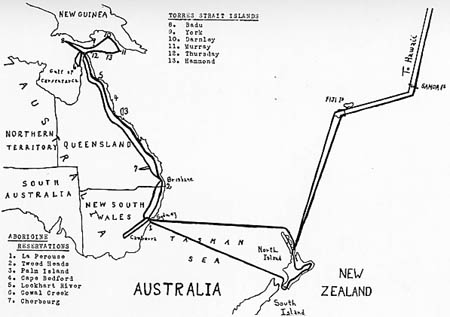
Isolated and modernized Australian Aborigines
OUR problem of throwing light upon the cause of the physical breakdown of our modern civilization, with special consideration of tooth decay and facial deformity, requires a critical examination of individuals living in as wide a range of physical conditions as may be possible. This requires that the Aborigines of Australia be included in this examination of human reactions to physical environments. These were studied in 1936.
In selecting the individuals in the various groups special effort was made to include children between the ages of ten and sixteen years in order to have an opportunity to observe and record the condition of the dental arches after the permanent teeth had erupted. This was necessary because the deciduous dentition or first set of teeth may be in normal position in the arches with a correct relationship between the arches, and the permanent dentition show marked irregularity. The shape of the dental arches of the infant at birth and the teeth that are to take their place in the arches have considerable of their calcification at birth. The development of the adult face, however, does not occur until the permanent teeth have erupted. The general shape or pattern is largely influenced by the position and direction of the eruption of the permanent teeth. These studies, accordingly, have included a careful, detailed record of the shape of the dental arch of each individual.
The Australian Aborigines constitute one of the most unique primitive races that have come out of the past into our modern times and they are probably the oldest living race. We are particularly concerned with those qualities that have made possible their survival and cultural development.
The Aborigines are of special interest because they have come out of a very distant past and are associated with animal life which is unique in being characterized as a living museum preserved from the dawn of animal life on the earth. Many of the animal species that are abundant in Australia are found only in fossil form on other continents. The evidence indicates that they crossed on a land bridge which connected Australia with Asia. After the bridge was submerged the animals persisted in that protected island continent which never has known any of the animal species of later development. Among these animals the marsupials play an important role and constitute a large variety. The American continent has only one or two of the many forms found in Australia. These are the opossum of the marsupial family and the sloth. One of the most curious animals living on the earth today, or that has left its remains in the petrified skeletons of early periods of the earth's history, is the duckbill platypus. It has the unique distinction of having the characteristics of several animal species. It lays eggs like a bird and hatches them with the heat of its body in its pouch. It has webbed, five-toed feet, like the water birds, a bill like a duck and hair and tail like a beaver. The typical marsupial pouch for carrying its young, is another characteristic of this strange animal. Like other mammals it provides milk for its young. Its milk is similar in chemical constituents to that of other mammals. Most rudimentary in form are the mammary glands of the platypus. The young, when hatched in the pouch, nuzzle the lining membrane of the pouch and the milk exudes through minute openings. There is no nipple. The animal lives chiefly in the water. Its home is built above the water level on the bank, but the entrance to it is underneath the water. They are exceedingly playful creatures, apparently more at home in the water than on land. They live on both animal life and plant food found under the water. They seem to be related to an early era of differentiation of animal species.

The Aborigines are credited with having the most primitive type of skeletal development of any race living today. The eyes are very deep set, the brows very prominent giving them an expression that identifies them as a distinct racial type. See Fig. 52. Professor Weidenreich has shown that they resemble in this regard the recently discovered ancient Peking man. While they are still in the Stone Age stage in their arts and crafts, they have developed further in some respects than has any other ancient race. Their skill in tracking and outwitting the fleet and very cunning animal life of their land is so remarkable that they have been accredited with a sixth sense. They have been able to build good bodies and maintain them in excellent condition in a country in which the plant life, and consequently the lower animal life can be maintained at only a very low level because of the absence of rain. Over half of Australia has less than ten inches of rain a year. It is significant that the natives have maintained a vigorous existence in districts in which the white population which expelled them is unable to continue to live. Among the white race there, the death rate approaches or exceeds the birth rate.
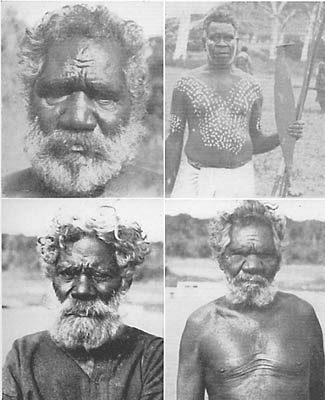
They have developed a device for throwing spears, which makes them more deadly than any in the world. I witnessed a group of the present-day natives throwing their spears at a target which consisted of a banana stalk much smaller than a man's body. They threw the spears from a distance which I estimated to be seventy-five yards. About thirty spears were thrown and several pierced the banana stalk and the others were stuck in the ground close around it. This was accomplished by means of a wamara or throwing stick approximately as long as the arm, with a strong hand grip at one end and a device on the other end for engaging in a depression in the butt of the spear. This was thrown by poising the spear about the level of the shoulder, the spear supported by the fingers of the hand which swung the throwing stick. The latter extended back over the shoulder. The impact of their spears has often been demonstrated to be sufficient to completely penetrate a man's body. Their method of tempering wood for the points of the spears was such that the spearheads offered great resistance. A throwing stick is shown in Fig. 52 (upper right).
These natives decorate their bodies with paints for dances and sports. They know the habits of all of the animals and insects so well that they are able to reproduce the calls of the animals and thus decoy them into traps. Some of the water birds maintain sentinels at lookout points to guard those in the water. The Aborigines are able to decoy these birds by most ingenious methods. They travel with their bodies disguised by grass and shrubbery and enter the water with a headgear made from feathers of one of the birds. Once in the water, they then maneuver in a manner similar to that of the birds and go among the flock of wild ducks or swans. Working entirely under water, they draw the birds under one by one and take load after load to shore without raising the suspicion of the flock. When working among the kangaroos they are so skilled in preparing movable blinds that they can kill many in a grazing wild pack without alarming the rest, always striking when the animal is grazing. Their skill at fishing probably exceeds that of any other race. They are so highly trained in the knowledge of the habits of the fish and the type of movement that the fish transmits to the water and to the reeds in the water, that one of their important contests between tribes is to see how many fish can be struck in succession with a spear, the fish never being seen, their only information as to its whereabouts being the change in the surface of the water and movement of grasses that are growing in the water as the fish moves. The fish are started by the umpire's striking the water. The experts bring up a fish six times out of eight. These fishing contests are held along the banks of lakes and rivers where the water is deep enough for some of the reeds and grasses to come to the surface. The contestants travel in canoes.
The native canoe is cut in one piece from the side of a tree, the cutting being done with stone axes. The canoe offers an exceedingly treacherous platform from which a standing man must throw his spear. For some of the contests the canoe carries a paddler, but in the most exacting contests the spear man must manage his own flat-bottomed canoe.
The skill of the Aborigines in tracking is so phenomenal that practically every large modern town or city in Australia has one or more of these men on its police staff today to track criminals. For weeks, they carry the detailed information about the characteristics of the prisoner's foot across the desert, and when they come across the man s foot print they recognize it among all others in the same path. Every leaf that is turned over or grain of sand on bare rocks has meaning for them.
Their social organization is such that almost every person who had been in intimate contact with them, testified that they had never known any of the Aborigines to be guilty of the theft of anything. Even where partly modernized, as they are in the large government reservations they are trustworthy. A nurse in an emergency hospital told me that she continually left her money, jewelry and other objects of personal property freely exposed and available where many of the hundreds of primitives passing could pick them up, and that she had never known them to take anything. The other nurses had had the same experience.
Every boy and girl among these Aborigines must pass many examinations. Their early schooling includes the tracking of small animals and insects. The small boys begin throwing spears almost as soon as they can stand up straight. No young man can even witness a meeting of the council, let alone become a member of it, until he has passed three supreme tests of manhood. First, he is tested for his ability to withstand hunger without complaint. The test for this is to go on a march for two or three days over the hot desert and assist in preparing the meals of roast kangaroo and other choice foods and not partake of any himself. He must not complain. If he becomes too weak, he is given a small portion. There are tests for fear in which he is placed under the most trying ordeals without knowing that it is part of his examination, and he must demonstrate that he will accept death rather than flee. No member of their society would be allowed to continue to live with the tribe if he had defied the ideals of the group. Immorality is cause for immediate death.
The growing boys among the Aborigines are taught deference and esteem for their elders in many impressive ways. A boy may not kill or capture a slow moving animal. That is left for the older men, whom he must call. He must limit his hunting primarily to the fast fleeing and canny kangaroos and wallabies, whom even a man on horseback cannot outdistance. Racketeers and such unsocial beings could not exist in this type of civilization.
Marriages are arranged according to very distinct tribal patterns and every girl is provided with a husband at a time decided by the council. Their code of ethics is built around the conception of a powerful Supreme Force that is related to the sun. They believe that there is an after-existence in which the myriads of stars represent the spirits of the Aborigines that lived before. The boys and girls are taught the names of the great characters that make up the different constellations. These were individuals who had conquered all of the temptations of life and had lived so completely in the interest of others that they had fulfilled the great motivating principle of their religion, which is that life consists in serving others as one would wish to be served. The seven stars of Pleiades were seven beautiful maidens that had surpassed most other girls in their devotion and service in the interest of their tribe. It is most remarkable how closely this concept is related to the classical myth regarding the seven daughters of Atlas and the nymph, Pleione.
A part of a young men's examination to determine his ability to withstand pain and his power of self-control consists in performing an operation at the time of his graduation. This operation is at the same time calculated to provide him with his badge of attainment. It consists of the boy's lying on his back and allowing the appointed operator to knock out one of his front upper teeth. This is done by putting a peg against the tooth and hitting it a series of sharp blows with a stone. He must endure this without flinching. We saw scores that carried this diploma. Prior to this, other very severe tests of physical endurance had been successfully completed.
The marvelous vision of these primitive people is illustrated by the fact that they can see many stars that our race cannot see. In this connection it is authoritatively recorded regarding the Maori of New Zealand that they can see the satellites of Jupiter which are only visible to the white man's eye with the aid of telescopes. These people prove that they can see the satellites by telling the man at the telescope when the eclipse of one of the stars occurs. It is said of these primitive Aborigines of Australia that they can see animals moving at a distance of a mile which ordinary white people can not see at all.
While these evidences of superior physical development command our most profound admiration, their ability to build superb bodies and maintain them in excellent condition in so difficult an environment commands our genuine respect. It is a supreme test of human efficiency. It is doubtful if many places in the world can demonstrate so great a contrast in physical development and perfection of body as that which exists between the primitive Aborigines of Australia who have been the sole arbiters of their fate, and those Aborigines who have been under the influence of the white man. The white man has deprived them of their original habitats and is now feeding them in reservations while using them as laborers in modern industrial pursuits. This contrast between the primitive Aborigines as they still exist in isolated communities in Australia and the modern members of the clans is not, however, much greater than that between these excellent primitives and the whites, near whom they are living.
In my comparative study of primitive races in different parts of the world, of modernized members of their groups and of whites who have displaced them, as well as in my study of our typical modern social organization, I have seldom, if ever, found whites suffering so tragically from evidence of physical degeneration, as expressed in tooth decay and change in facial form, as are the whites of eastern Australia. This has occurred on the very best of the land that these primitives formerly occupied and becomes at once a monument to the wisdom of the primitive Aborigines and a signboard of warning to the modern civilization that has supplanted them. Their superb physical excellence is demonstrated in every isolated group in the primitive stocks with which we came in contact. For tribes that have lived along the coast and had access to the sea foods, their stature was large and well formed.
When living in the Bush they are largely without clothing. Where they are congregated in the reservations they are required to wear clothing. It is important to note in these people the splendid proportions of the faces, all of which are broad, with the dental arches wide and well contoured. This is Nature's normal form for all humans and is shown in Figs. 53 and 54 (upper right). The person in Fig. 53 (upper left) is a woman.
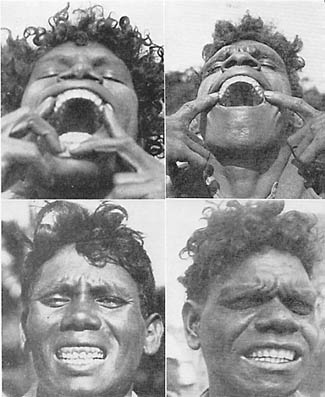

Various factors in the changed environment were studied critically. Samples of foods were gathered for chemical analysis; and the changes in the modern diet from that which was characteristic of the primitives were studied. When the teeth of the primitives and the teeth found in the skulls that had been assembled in the museums were examined, it was found that dental caries or tooth decay was exceedingly rare among the isolated groups. Those individuals, however, who had adopted the foods of the white man suffered extremely from tooth decay as did the whites. Where they had no opportunity to get native food to combine with the white man's food their condition was desperate and extreme. This is readily disclosed in Fig. 54. Note contrast with upper right. It is quite impossible to imagine the suffering that these people were compelled to endure due to abscessing teeth resulting from rampant tooth decay. As we had found in some of the modernized islands of the Pacific, we discovered that here, too, discouragement and a longing for death had taken the place of a joy in living in many. Few souls in the world have experienced this discouragement and this longing to a greater degree.
One of the most important phases of our special quest was to get information that would throw light on the degeneration of the facial pattern that occurs so often in our modern civilization. This has its expression in the narrowing and lengthening of the face and the development of crooked teeth. It is most remarkable and should be one of the most challenging facts that can come to our modern civilization that such primitive races as the Aborigines of Australia, have reproduced for generation after generation through many centuries-no one knows for how many thousands of years-without the development of a conspicuous number of irregularities of the dental arches. Yet, in the next generation after these people adopt the foods of the white man, a large percentage of the children developed irregularities of the dental arches with conspicuous facial deformities. The deformity patterns are similar to those seen in white civilizations. Typical illustrations of this will be seen in Figs. 55 and 56. Severe deformities of the face were frequently seen in the modernized groups, as evidenced in Fig. 57.
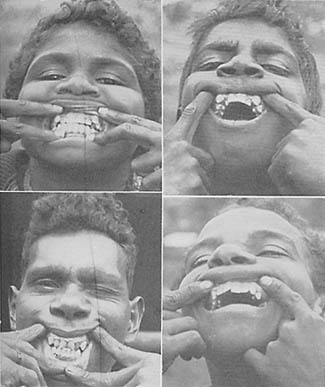
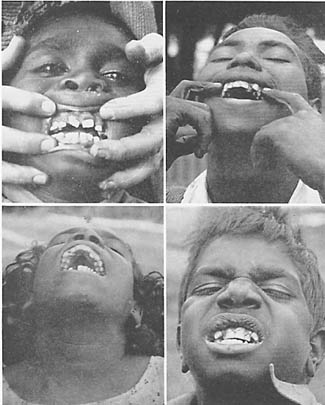
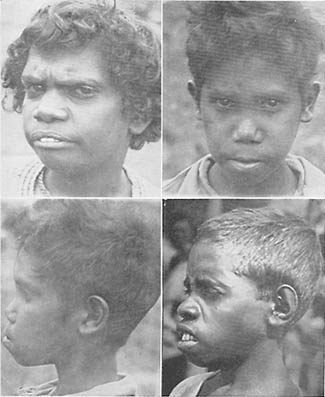
The data obtained from a study of the native Australians who are located in a reservation near Sydney, at LeParouse, revealed that among the Aborigines 47.5 per cent of the teeth had been attacked by dental caries, and 40 per cent of the individuals had abnormal dental arches. For the women of this group, 81.3 per cent of all the teeth had been attacked by dental caries, and for the men, 60.4 per cent, and for the children, 16.5 per cent. In this group 100 per cent of the individuals were affected by dental caries.
Palm Island is a government reservation situated in the ocean about fifty miles from the mainland, off the east coast of Australia, about two-thirds of the way up the coast. It was reached by a government launch. Included in the population of this reservation are a large number of adults who have been moved from various districts on the mainland of Central and Eastern Australia and many children who were born either before or after their parents were moved to this reservation. The food available on the Island is almost entirely that provided by the government. Of ninety-eight individuals examined and measured, 53.1 per cent of them had dental caries. For the group as a whole, 8.9 per cent of all of the teeth were affected; for the women, 21.2 per cent; for the men, 14.2 per cent; and for the children, 5.8 per cent. Fifty per cent of the children had deformed dental arches, which occurred in only 11 per cent of the adults.
Cape Bedford is situated about three-fourths of the way up the east coast and is so isolated that it was necessary for us to use a special aeroplane to reach it. Landing was made on the beach. This group of people is under the management of a German Lutheran missionary. They are dependent almost entirely on the food provided by the mission and the government. The official in charge had spent fifty years in devoted service to these native people. We found him exceedingly sad because of the very rapid breakdown that was in progress among the natives in his care. The dental caries for the group of eighty-three individuals studied was 12.4 per cent of their 2,176 teeth examined. For the women, this amounted to 37.2 per cent of the teeth; for the men, 8.4 per cent; and for the children, 6.1 per cent. Of the eighty-three individuals, 48.1 per cent had been affected by dental caries. Many of the adults in this group had been born on plantations under the influence of the modern nutrition, and many of the children had been born in the mission. For the adults, 46 per cent had abnormally formed dental arches, and for the children, 41.6 per cent. We were advised that deaths occurred very frequently from tuberculosis. This reservation does not provide the natives with natural hunting grounds capable of providing the people with animal life for food. The coast for some distance inland is a series of sand dunes which are slowly being transferred over the vegetation by wind, completely smothering it. While the coast is well supplied with a variety of deep-water fish the natives have practically no equipment for obtaining them, a condition which restricts them very largely to the use of the imported foods supplied by the officials.
Our next stop, using the special aeroplane, was at Lockhart River, which is about four-fifths of the way up the east coast of Australia. Here again we were able to land on the beach near a large group of primitive Aborigines. The isolation here is so nearly complete that they are dependent upon the sea and the land for their foods. This part of Australia, namely, the York Peninsula, is still so primitive that there has been very little encroachment by the white population. It will be remembered that in this area there are no roads, the country being a primitive wilderness. Of fifty-eight individuals examined, their 1,784 teeth revealed that only 4.3 per cent had been attacked by dental caries. For the women, this amounted to 3.4 per cent; for the men, 6.1 per cent; and for the children, 3.2 per cent. Some of these men had at some time worked on cattle ranches for the white men. Of the children, only 6.3 per cent had abnormal dental arches, and of the adults, 8.7 per cent. In this group, therefore, 91.4 per cent of all ages had reproduced the typical racial pattern as compared with 56 per cent of the group at Cape Bedford, 62 per cent of the group at Palm Island, and 60 per cent at LeParouse. At Lockhart River, 32.7 per cent of the individuals had dental caries.
A reservation called Cowall Creek on the west side of York Peninsula situated on the Gulf of Carpenteria, was reached by flying our special plane to Horn Island in the Torres Strait north of Australia and proceeding from there by boat to Thursday Island, and on, by boat, to Cowall Creek. In this reservation thirty-five individuals were studied and found to be in a very pathetic condition. We were told that deaths occurred frequently. Of the 976 teeth examined, 24.6 per cent had been attacked by tooth decay. For the women, this amounted to 60.7 per cent; for the men, 30.4 per cent; and for the children, 8.9 per cent. Forty-nine and six-tenths per cent of the individuals studied had abnormal dental arches. Of the children 66.6 per cent had deformed dental arches, and 9 per cent of the adults. Many of these adults had been raised in the bush. Of the individuals studied, 68.6 per cent had had dental caries. One can scarcely visualize, without observing it, the distress of a group of primitive people situated as these people are, compelled to live in a very restricted area, forced to live on food provided by the government, while they are conscious that if they could return to their normal habits of life they would regain their health and again enjoy life. Many individuals were seen with abscessing teeth. One girl with a fistula exuding pus on the outside of her face is shown in Fig. 58 (upper right). In their native life where they could get the foods that keep them well and preserve their teeth, they had no need for dentists. Now they have need, but have no dentists. It is easy to chide and blame the officials who provide them with the modernized foods under which they are breaking, but it must be remembered that practically all modern civilizations are more or less in the same plight themselves.
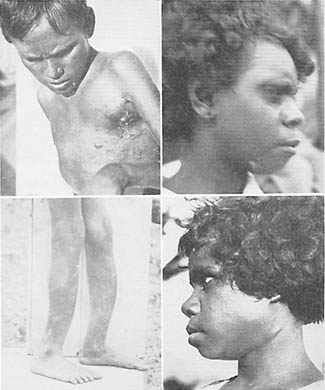
An opportunity was provided for examining a group of the native Aborigines of Australia who made up the crew of eighteen for a pearl-fishing boat. Of this group, 5.7 per cent of their 554 teeth had been attacked by tooth decay. These individuals could be readily divided into two groups; namely, those who had been raised in the Bush and those who had been raised in missions. For the thirteen raised in the Bush, not a single tooth of their 364 teeth had ever been attacked by tooth decay and not a single individual had deformed dental arches. In contrast with this, of the five raised in the mission, 19.3 per cent of their 140 teeth had been attacked by tooth decay and 40 per cent of these individuals had abnormal dental arches.
The cook on the government boat was an aboriginal Australian from Northern Australia. He had been trained on a military craft as a dietitian. Nearly all his teeth were lost. It is of interest that while the native Aborigines had relatively perfect teeth, this man who was a trained dietitian for the whites had lost nearly all his teeth from tooth decay and pyorrhea.
In the group of Aborigines so far reported, there were many who had come from the interior districts of Australia and many who had always lived near the coast. These two types of districts provided quite different types of foods. Those near the coast were able to obtain animal life from the sea, including fish, dugong or sea cow, a great variety of shell fish, and some sea plants. Those from the interior districts could not obtain animal life of the sea, but did obtain animal life of the land which was eaten with their plant foods in each case. It was quite important to reach a group of Aborigines who had always lived inland and who were on a reservation inland. This contact was made with the group at a government reservation called Cherbourg. A typical group of individuals was examined. Of forty-five individuals with 1,236 teeth, 42.5 per cent of the teeth had been attacked by tooth decay. For the women, this constituted 43.7 per cent; for the men, 64.6 per cent; and for the children, 5.6 per cent. Of all of the individuals here examined 64.5 per cent had dental caries. It is of interest that many of these men had worked on white men's cattle ranches. While the adults showed 11.7 per cent to have deformed dental arches, this rose to 50 per cent for the children of the group. We were informed that in all of these groups tuberculosis was taking a very heavy toll. In Fig. 58, upper left, will be seen a boy with a superating tubercular gland of the axilla; at the right, a girl with a fistula draining pus onto the outside of the face from an abscessed tooth; below, deformed legs and a girl with tubercular glands of the neck.
A reservation situated on the coast where sea foods were available might be expected to make available a particular type of nutrition through sea foods. The individuals in a reservation for the Aborigines at Tweed Heads, which is so situated, were studied. Of the twenty-seven individuals examined, 89 per cent had dental caries. Of their 774 teeth, 39.7 per cent had been attacked by dental caries. For the women, this amounted to 62.5 per cent; for the men, 70.9 per cent; and for the children, 20.8 per cent. Most of these children had been born in this environment while their parents were being fed, largely, the foods provided by the government and mission. In this group, 83.4 per cent of the children had deformed dental arches, and 33.3 per cent of the adults.
An interesting incident was brought to my attention in one of the Australian reservations where the food was practically all supplied by the government. I was told by the director in charge, and in further detail by the other officials, that a number of native babies had become ill while nursing from their mothers. Some had died. By changing the nutrition to a condensed whole milk product, the babies recovered. When placed back on their mother's breast food they again became ill. The problem was: Why was not their mothers' milk adequate? I was later told by the director of a condition that had developed in the pen of the reservation's hogs which were kept to use up the scraps and garbage from the reservation's kitchens. He reported that one after another the hogs went down with a type of paralysis and could not get up. The symptoms were suggestively like vitamin A deficiency in both the babies and the hogs, and indicated the treatment.
The rapid degeneration of the Australian Aborigines after the adoption of the government's modern foods provides a demonstration that should be infinitely more convincing than animal experimentation. It should be a matter not only of concern but deep alarm that human beings can degenerate physically so rapidly by the use of a certain type of nutrition, particularly the dietary products used so generally by modern civilization.
The child life among the Aborigines of Australia proved to be exceedingly interesting. Children develop independence very young and learn very early to take care of themselves. Mothers are very affectionate and show great concern when their children are not thriving. Two typical mothers with their children are shown in Fig. 59. These children, as suggested in the picture, were keenly interested in everything that I did, but were not alarmed or frightened.

The wonderful wisdom of these primitive people was attested by the principal of the public school at Palm Island. A mother died and her nursing infant was taken care of by its maternal grandmother, who had not recently given birth to a child. She proceeded to carry out the primitive formula for providing breast food by artificial means. Her method was to make an ointment of the fresh bodies of an insect which made its nest in the leaves of a certain tree. This she rubbed on her breast and in a short time produced milk liberally for this foster child. I was shown the type of insect, photographed its nest and the colony inside when the nest was opened. The people who vouched for this circumstance declared that they had seen the entire procedure and knew the facts to be as stated. They further stated that this was common knowledge among the Aborigines.
Another important source of information regarding the Aborigines of Australia was provided by a study of the skeletal material and skulls in the museums at Sydney and Canberra, particularly the former. I do not know the number of skulls that are available there for study, but it is very large. I examined many and found them remarkably uniform in design and quality. The dental arches were splendidly formed. The teeth were in excellent condition with exceedingly little dental caries. A characteristic of these skulls was the evidence of a shortage of material for those that had been transferred to a museum from the interior arid plains country. Those skulls, however, that had come from coastal areas where sea foods were available, show much more massive dimensions of the general pattern. In Fig. 60 will be seen typical skulls showing the normal dental arches and general design of the head. It is of interest to note the very heavy orbital ridges which characterize this race.

I have previously referred to a report by Professor Weidenreich regarding the resemblance of the Australian native's skulls to those of the recently discovered Peking man in the caves of China. In Fig. 60 are two views for comparison. The skull at the left is that of an Australian primitive photographed in a museum in Sydney, and an outline of the Peking skull is shown at the right. Professor Weidenreich has emphasized the observations that when three skulls are put in series, namely, the Australian primitive, the Peking skull and a chimpanzee skull, the Peking skull appears to be about half way between the two in design and developmental order. The Australian primitive's skull is higher in the crown, showing much greater brain capacity. The supra-orbital depressions are less deep in the Peking than in the chimpanzee, and still less deep in the Australian primitive. The supra-orbital ridges which produce the prominent eyebrows are less pronounced in the Australian primitive than in the Peking man, and still more prominent in the chimpanzee. The prominent supra-orbital ridges of the chimpanzee face are shown in Fig. 48.
The age of the Peking skulls has been variously placed from several hundred thousand to a million years. A distinguished anthropologist has stated that the Australian primitives are the only people living on the earth today that could be part of the first race of mankind. It is a matter of concern that if a scale were extended a mile long and the decades represented by inches, there would apparently be more degeneration in the last few inches than in the preceding mile. This gives some idea of the virulence of the blight contributed by our modern civilization.
The foods available for these people are exceedingly limited in variety and quantity, due to the absence of rains, and unfertility of the soil. For plant foods they used roots, stems, leaves, berries and seeds of grasses and a native pea eaten with tissues of large and small animals. The large animals available are the kangaroo and wallaby. Among the small animals they have a variety of rodents, insects, beetles and grubs, and wherever available various forms of animal life from the rivers and oceans. Birds and birds' eggs are used where available. They are able to balance their rations to provide the requisites for splendid body building and body repair. In several parts of Australia, which originally supported a large population of the primitives, none are left except a few score in reservations. These also are rapidly disappearing. Their fertility has been so greatly reduced that the death rate far exceeds the birth rate.
This group provides evidence of exceptional efficiency in obeying the laws of Nature through thousands of years, even in a parched land that is exceedingly inhospitable because of the scant plant foods for either men or animals. While the Aborigines are credited with being the oldest race on the face of the earth today, they are dying out with great rapidity wherever they have changed their native nutrition to that of the modern white civilization. For them this is not a matter of choice, but rather of necessity, since in a large part of Australia the few that are left are crowded into reservations where they have little or no access to native foods and are compelled to live on the foods provided for them by our white civilization. They demonstrate in a tragic way the inadequacy of the white man's dietary programs.
Next
Table of Contents
Back to the Small Farms Library